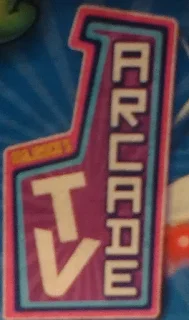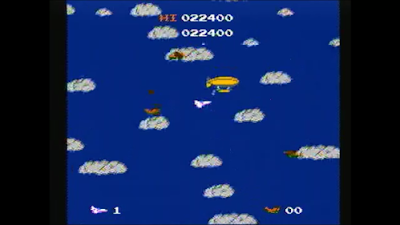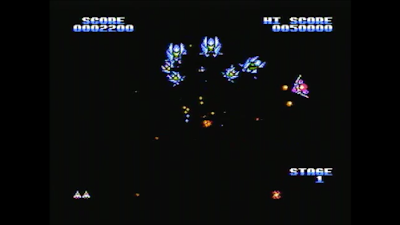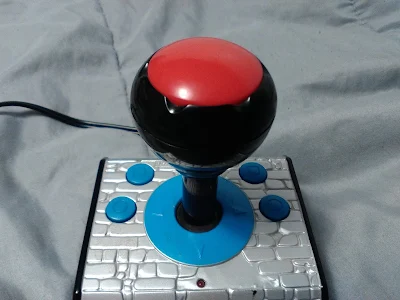...Yeah, I don't have a long winded, irrelevant intro this time. I'll save that for later in this post, so let's just get to it.
--------------------------------------------------------------------------------------------------------------------
Game: Konami Collector's Series: Arcade Advanced
Manufacturer: Majesco
Release Date: 2004
Genre: Arcade
So, before Steam and Good Old Games and Xbox Live and WiiWare and all those other online stores that sell retro and enhanced older games, the three ways available to play older games were either A) own the older games and consoles, which becomes harder and harder as working consoles and games get scarcer, B) download roms off the internet, find a decent emulator, and hope your early 2000s computer is powerful enough to handle the strain, or C) buy compilation cartridges and discs for whatever system you own and hope the game contains what you want. Guess which option we're looking at today...
Now obviously, we still have compilations released on physical media today, but back in the early 2000s, it was basically the only way to play classic games without having to buy increasingly rarer and inferior hardware.
And this is where Plug n Play games found their niche, including today's offering, the Konami Collector's Series: Arcade Advanced. Or "KCSAA"(which is pronounced "kick-sah" for anyone who hasn't brushed off their acronym-pronunciation dictionary in some time.)
Interestingly, this is actually a later PORT of the game, as the collection was also released on the Game Boy Advance in 2002 by Konami under the same name. ...However, I use the term "port" loosely, as the GBA version seems to feature enhanced versions of the games, as well as an intro screen, a soundtrack, and various other effects and tweaks that the dedicated console is missing. I also read that the Konami code causes various effects with each individual game in the GBA version, but it did nothing in the console version, so an extra 30 lives eluded me during this playthrough.
So the first question that comes to mind with this console's design is... what did they design it AS? I get the impression that it's supposed to look like an arcade cabinet, or at least the portion where the joystick is supposed to go, but then why the layered bricks? There are no medieval themed games on this compilation and only one game that takes place during a war, but as far as I can tell, there are no castles or stone buildings in that either. It's like they were designing a body for another game they were going to release, but something happened that made them stop building it halfway through, so they just slapped some arcade stickers on the sides and downloaded a completely different game into it...
Also, there's the inconsistent art on the front. On the right, we have the frog from Frogger when he's made it across the pond and a generic shot of the ship from Scramble. Ok, they're both in the game and they're representative of the pixellated nature of their respective games. ...But then on the left, we have a picture of the main red-haired guy from Yie Ar Kung-Fu, except from a different version than is included in the compilation... And in the upper left corner, we have what looks like promotional art from Gyruss, with quality way too good to be included in the arcade version. It's like they just typed the game names into Google and copy-pasted the first things that popped up.
I mean what sort of lazy idiot do you have to be to just take the first picture you see on a web search, am I right?
The art on the sides looks fine though. On the left, we have promotional art of Frogger and Time Pilot
And on the right, we have Bruce Lee posing for for Yie Ar Kung-Fu... and the exact same Time Pilot picture again, just flipped horizontally. ...Really guys...? You have SIX games on here, you could have put SOMETHING from any of the other three, you know!
The control layout on the top is pretty basic, with two generic buttons for player actions, a joystick, a start button, and a reset button, but I'm surprised that they actually made a left-handed option for southpaw players! Out of curisoity, I played a bit with the left-handed option and it worked quite well. That's surprisingly courteous of a budget TV game not many people are going to play...
So when we boot this up, we see that the publisher of this port was Majesco, a budget game company mostly famous for games like Bloodrayne, Cooking Mama, and, unfortunately, Drake of the 99 Dragons, and for critically-lauded flops like Psychonauts and Advent Rising.
They also released a line of Plug n Play titles under their Majesco's Tv Arcade name... which from what I can find is comprised of this, a standalone port of Frogger, and a casino game based on the Golden Nugget Casino... which is also a port of a GBA game. ...Did I mention that Majesco got its start, and still receives a good portion of sales today, by repackaging other developers' games into low-priced compilations?
When the game gets to the title screen, I'm unfortunately really annoyed by the 8-bit mess that is the title music. It doesn't sound too bad, but having played hundreds of games in X-in-1 compilations, this type of music pretty much instantly turns me off...
The console is comprised of six Konami Arcade games: Frogger, Scramble, Time Pilot, Gyruss, Yie Ar Kung Fu, and Rush'n Attack. Now the problem with reviewing compilations of previously released games is that I can't judge the console based on the quality of the games, since it's not the fault of the publisher if the games are good or not. So instead, I'm going to quickly run though each game and give some thoughts on each and how well they're emulated on this console.
Frogger(1981): An arcade classic that pretty much everyone and their dog has played in some form. Get the frog across the traffic, jump on the logs and turtles floating in the water, and get 5 frogs to hop to an available space to proceed.
For the most part, this is a great port. The colors are the same, the control is pretty fluid, and it's all on one screen rather than having to scroll like in the GBA version. For some reason, though, they relocated the score to the bottom left instead of the top of the screen like in the arcade. ...But what really ruins it for me is the music. They replaced the friendly and familiar tune with a stock 8-bit song that REALLY gives me 50-in-1 flashbacks, so that knocks the game's enjoyability factor down quite a few points. Also, the sound effects have changed to stock, and VERY piercing, beeps and blips, from Frogger's jumping sound to the sound of being run over. I really don't get why, since I don't think the sound would have been too hard to replicate on one of these consoles. Was there a rights issue? Could they only get the license to the game but not the music? I'm confused... Still, it's a good port. Just mute the volume and you'll probably have fun.
Scramble(1981): A mediocre side-scrolling space shooter that didn't hold my attention for too long. Get from the beginning to the end, shoot everything in your way, and battle the big bad at the end. ...At least, that's what I assume, since I didn't really care that much for this game to get anywhere...
Strangely, my copy has a glitch where 9 times out of 10, when you start this game from the menu, it skips the title screen and goes straight into the game, which I didn't notice until after I had recorded the footage and I didn't have time to get more, hence the arcade title screen instead of the game's. ...However, that's the least of this game's problems. To start, as with the Frogger game, they put the Score in the bottom left corner as opposed to the top, and also removed the progress bar at the top. The sprites have also been redrawn and with fewer frames-per-second, not only giving the images janky animation as they move, but also causing some letters in text, especially with the Fuel stations, to become transparent. Also no stars twinkling in the background. But the strangest change is that, in addition to again changing the sounds to much blander stock replacements, they ADDED music to a game that didn't have it before! Yes, for some reason, they added a stock score to the gameplay which the arcade version lacked, and in this case, I REALLY wish they didn't. It just makes this game all the more generic and dated. Overall, bad port of a game that hasn't aged well...
Time Pilot(1982): One of the first free-roaming shooter games and not too bad of one. Defeat different enemies across time, save pilots, fight the boss, lather, rinse, repeat.
Once again, the sound effects have been changed, and this time, they removed the music entirely, which considering the music quality before, is probably for the best. And hey, they put the Hi Score where it actually needs to be... though they also simplified the Life and Enemy meters to just the number left of each. The clouds have also been simplified to just a static background design, with the ability to fly behind certain clouds completely removed. Besides that, not too shabby a port for not too shabby a game.
They even have a Hi Score table to enter your initials when you've shown you're better than the placeholder names. ...Mind you, they don't SAVE the high scores, but I appreciate the gesture.
Gyruss(1983/1988[see below]): A space shooter that's sort of a mix between Tempest and Galaga. The space ship is positioned in the foreground and enemies come in behind the player and line up in the background to be shot down in a pseudo-3D style.
This is simultaneously the best and the worst port on here. Why? It's a straight-up port of the NES! They changed absolutely nothing, they just took the ROM image from the 1988 Nintendo Entertainment System release and put it into the collection. That's why the title reads 1988 when the arcade version was released in 1983. It was a lazy move... but it was probably the best thing they could have done for this console. The NES version is well known for being a far superior update of the Arcade version, with better graphics, sounds, music, and power-ups, and for including boss fights and additional levels absent from the arcade. So while I should be mad that they did this when they promise the "arcade" versions in this compilation, I'm so thrown off by the vastly superior graphics and actual soundtracks compared to most of the other games on here that I can't bring myself to do so! ...Unfortunately, it's hampered a bit by the bad controls on the console.
Something I didn't mention earlier is that the joystick on this console is pretty badly made. I get that it's emulating an arcade stick, but there's a reason why controllers have buttons and/or little thumbsticks on them as opposed to big honkin' joysticks.
In an arcade, the gamer is standing, bent over the controls and staring at the screen directly in front of him or her. In one hand is the arcade joystick, while the other hand flies over the button or buttons on the other side of the machine's layout. Everything is held steady for the gamer to put his or her full weight on the machine and the joystick is oversized to allow the gamer's hand to wrap around it, providing a tight grip to evade 8-bit projectiles at a moment's notice.
Console gamers have no such support. They are slouched back in their seats, often with their legs up on a table, holding the controller. All buttons are situated on the controller, often with a larger amount than most arcade machines contain, and all have to be close enough to be accessible at a moment's notice, the gamer's fingers switching back and forth between them with no delay. So basically, the gamer is holding onto the controller for dear life while at the same time darting between several buttons to pull off a basic character movement on screen. This means that all buttons must be small enough for the player's fingers to press without taking their hand off the controller, otherwise their playing speed is hindered and they will probably drop it.
Older controllers, like the Atari 2600, only contain one button and have a thin, shorter joystick, allowing one hand to grip it comfortably while the other wraps around the bottom of the controller as the player puts his or her thumb on the button.
This controller on the other hand is much more bulky than an Atari 2600 controller with a fat bulb on the top that prevents the player from holding the joystick comfortably and two buttons that the player's thumb must quickly switch between. This makes the game really hard to control and hold onto when quick movements are required. In games like Frogger, Scramble, and Time Pilot, which are more focused on one particular button, left/right movements, and only slight taps up and down, it works, but with games that make frequent use of the entire range of the controller and both buttons, aka the rest of the games on this console, it leads to hand cramps and a hard time with the more "upward" directions. Unless it's placed on a table where the hands can be more free to move around, circular motions and frequent jumps requiring the joystick to move up and a direction are really hard to pull off with this controller.
This has been another "Game History You Don't Need To Know, But Presenting It Gives The Illusion I'm Smart!"
Oh, and as for the Gyruss game: Probably the best quality game on this system. Not the arcade, but a high quality port nonetheless.
Yie Ar Kung-Fu(1985): One of the first fighting games, and boy does it show... Your player handles like a brick as you attempt to punch, kick, jump over, and avoid the other fighter.
And, once again, we have a direct NES rip. Except while Gyruss was a superior port to the arcade, this is a pretty watered-down version. The background is limited to the inside of a dojo rather than the world, the sound effects are pretty stock, the graphics are much blander, and the control is much less refined. Here, the oversized joystick basically made it impossible to play, since you have to push UP to JUMP, and the directional pad makes it hard to jump in the direction you want to go in. So for most of the game, all you can do is jump around. Jump around. Jump up jump up and get down. Also, being one of the first fighting games, it's nearly impossible to tell if and how your hits land. It has something to do with striking when the enemy is about to throw a punch, but it basically just came down to button-mashing for me and I didn't last very long. So this game is hard and pitiful enough on the NES, you don't need to play one with even worse control.
And finally, Rush'N Attack(1985/1987): a pre-Contra side-scrolling Run 'n Gun that has one of the most generic titles I've ever heard. Its original name was Green Beret, so why change it? It's like calling Super Mario Bros. "Slide 'n Run", or Sonic the Hedgehog "Spin 'n Dash", or Bubble Bobble... never mind.
And, once again, it's the NES port. ...Guys, I know your first three ports weren't exactly high quality, but if you're going to resort to porting NES versions, just retitle it "Konami's NES Classics" or something... However, to be fair, this is the game that caught my interest the most. You play a Spec-Ops soldier in charge of blowing up secret weapons during the Cold War and, with the exception of limited use weapons lying around, you're armed only with a short-range knife... which I think is pretty stupid for a special forces soldier to have as his sole armament. The graphics aren't bad, the soundtrack is catchy, and the difficulty is challenging, but in the fun way that makes you want to play again. ...The only problem, again, is the awkward joystick control that makes it hard to push up and jump. The game is already hard enough, but trying to maneuver the character over mines and under flying kicks is stupidly difficult when it shouldn't be. Since it's an NES port, I'd recommend playing the actual NES game, but if you think you can overlook the bad control and if you're a fan of games that combine platforming and shooters like Contra or Metal Slug, you might like this one.
And that's the compilation for you... and what a strange one it is. It's like they started out just manually building the arcade classics over from scratch, then said "screw it", downloaded a few ROMs and emulation software, put it on an SD card, and installed it. ...In fact, I'm halfway curious to find out if there is just a memory card of some sort inside, like what they did with the Neo Geo X, where they said it faithfully reproduced arcade classics when it actually just had a buggy emulator installed... Hmmm...
Well, despite initial hesitation, I went ahead and took the console apart. It's just a regular motherboard under there, no sign of soldered SD cards anywhere. Too bad. I wanted to know what would have happened if I tried to load some homebrews on there. Wouldn't that have improved the console if I could play "Somari"...?
-------------------------------------------------------------------------------------------------------------
Design: The design is bizarre and clunky. Again, it's like they started out making a console for a specific game, then changed their minds halfway through and slapped some arcade artwork on it. The joystick is bulky and hard to hold and the overall bulk makes it awkward to hold for long periods of time. However, I'm a little amused at their random art placement and how they just plastered art from the game, regardless of the port. Also, bonus design points for being courteous enough to include a left-handed option.
Controls: As I mentioned, the oversized joystick makes the game hard to control if you're just holding it in your hands, especially with the games that require you to push up to jump. These are definitely games that require either a looser arcade joystick or a control pad to move around without unneeded difficulty. However, there weren't any games that I felt controlled stiffly or unresponsively and, again, I'm happy they installed controls for people who prefer to play left-handed.
Music & Sound: This depends on the port. For the first three games, which seem to be arcade ports built from the ground up, the sounds are just stock NES-style sounds that can really get irritating if played repeatedly, while the music, when they bother to include it, is again just tuneless drek that only barely matches the game its paired up with. The NES ports, on the other hand, do contain appropriate sound effects and the music is very catchy, especially with Gyruss and Rush'N Attack, though I like the Oriental riffs in Yie Ar Kung-Fu. So just split the difference I guess.
Graphics: Again, this varies by port, but not by as much. Frogger is fine, Scramble is boring and bland, and Time Pilot is somewhere in between. The NES ports are all really well detailed, with Gyruss being the best out of the bunch, and the animation and cut scenes are fluid and fun to watch. Overall, the graphics aren't too bad on here, but a little more polishing and arcade-faithful effects would have really helped this be more visually appealing.
Gameplay: The games I had the most fun playing were Gyruss and Rush'N Attack, while the least were Scramble and Yie Ar Kung-Fu, but since this is a compilation of previously-released games, I can't really praise or fault the console for it. I can say that the games run really well on the console and they control with no delay, though since these are emulated, small glitches do occur(skipping title screens, flickering/disappearing sprites, sound malfunctions and pitch fluctuations, etc.) Also, in order to choose another game, the system has to be reset over from the beginning, which involves sitting through the various companies over again, that can get old fast. Overall, it has a good library of some fun games and it runs them pretty well.
Replay Value: They're classic arcade games that are quite challenging and fun, so you'll probably want to revisit them over and over again to see how far you can get. However, the lack of a save feature for high scores does ruin this a little and the controls can be frustrating. Still, for a cheap compilation of games, it has a lot to come back to.
Overall:
They're decently emulated games that are really fun and contain a lot of material for hours of gameplay. It would have been nice to get the actual arcade classics as opposed to watered-down ports and NES games, and I'd more recommend getting the actual games or buying a higher-quality compilation on a console you can switch out the controllers to tailor to your style, as well as save high scores, but if you just want to play the games and you don't care as much about the graphics or ports, then try the Kick-Sah on for size.






































No comments:
Post a Comment